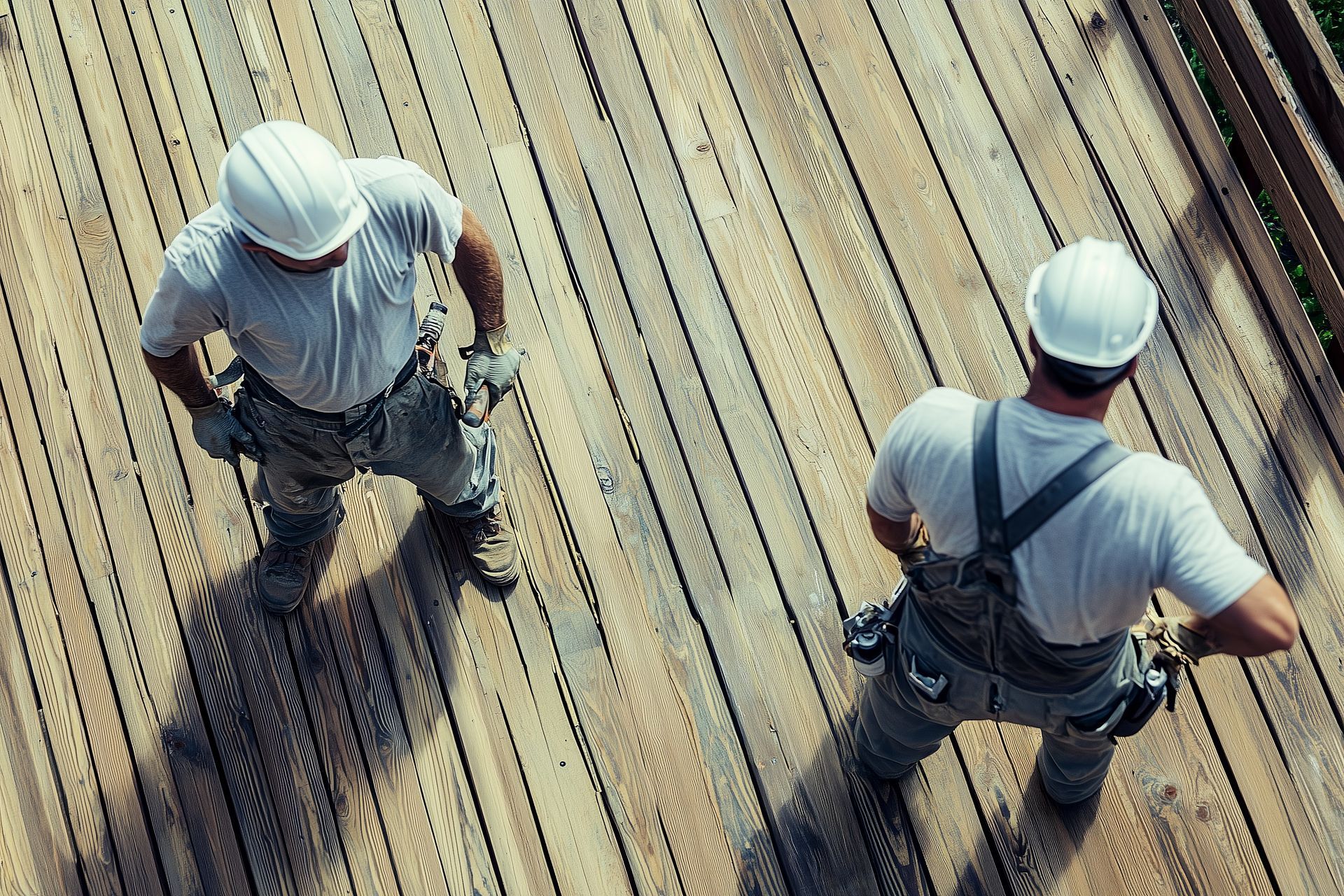Why Deck Railing Style Matters for Stafford Homeowners

When planning a custom deck for your Stafford, VA home, most homeowners focus on size, layout, and materials. But one element that often gets overlooked—yet plays a huge role in both safety and style—is the deck railing. Far more than a structural necessity, your railing system frames the entire outdoor space, influences curb appeal, and even affects how open or private your deck feels.
For homeowners in Stafford, choosing the right railing style means balancing function, aesthetics, and local building codes—all while complementing your home’s architecture. Whether you prefer the timeless look of wood, the sleek lines of cable rail, or the low-maintenance appeal of composite materials, the right railing can elevate your entire outdoor living experience.
Deck railings are more than just a safety feature. They:
- Enhance your home's exterior look
- Reflect your personal design preferences
- Improve safety for elevated decks or stairs
- Add to the overall value of your deck
Choosing the right railing means finding a balance between aesthetics, durability, and code compliance, all while working with qualified deck railing contractors who understand local guidelines in Stafford.
Popular Deck Railing Styles for Homes in Stafford
Let’s explore the most common and stylish railing types of local homeowners are choosing today.
1. Classic Wood Railings
Wood railings offer a timeless, natural look that complements traditional-style homes in Stafford.
Pros:
- Budget-friendly material
- Easy to customize (paint/stain)
- Warm, natural appeal
Cons:
- Requires regular maintenance
- Prone to rot or warping over time
Great for: Colonial, farmhouse, or rustic homes
2. Composite Railings (Including Trex)
Composite railings are made from recycled materials, similar to composite decking products.
Pros:
- Extremely low maintenance
- Moisture and UV-resistant
- Available in various colors and finishes
Cons:
- Higher upfront cost
- Limited customization once installed
Great for: Busy homeowners looking for a clean, modern finish that lasts
3. Aluminum and Metal Railings
Metal railings—especially powder-coated aluminum—are a popular choice for modern or transitional decks.
Pros:
- Sleek and contemporary design
- Long-lasting and weather-resistant
- Minimal maintenance
Cons:
- May not suit traditional home aesthetics
- Can be more expensive than wood
Great for: Modern or upscale homes seeking a minimalist look
4. Cable Railings
Cable railings offer unobstructed views and are a favorite for homes with scenic backyards or open landscapes.
Pros:
- Virtually invisible from a distance
- Strong and durable
- Modern appearance
Cons:
- Higher installation costs
- Tension adjustments may be needed over time
Great for: Decks with scenic views or elevated platforms
5. Glass Panel Railings
If you want style and visibility, glass railings are a sleek and luxurious option.
Pros:
- Clear views of surroundings
- Elegant and upscale appearance
- Wind protection
Cons:
- Needs frequent cleaning
- More expensive than most other options
Great for: Luxury homes, patios with views, or wind-prone areas
6. Mixed Material Railings
Mixed railing styles—such as composite posts with metal balusters—offer a balanced look that blends classic and contemporary design.
Pros:
- Highly customizable
- Can combine durability with aesthetic appeal
- Let's you match the deck to your home's architecture
Cons:
- May require coordination between materials and styles
- Pricing varies depending on components
Great for: Homeowners who want a unique, customized deck appearance
Deck Railing Code Requirements in Stafford, VA
- When it comes to deck safety, building codes aren’t just suggestions—they’re mandatory and must be followed precisely to ensure your structure is secure and up to standard. Whether you’re planning a new deck or upgrading an existing one, your contractor for deck railing installation should be fully knowledgeable about these local and national code requirements.
- Here are some key safety regulations that typically apply in Stafford and most parts of Virginia:
- Decks 30 inches or more above the ground must have railings
This is a critical safety rule that helps prevent dangerous falls, especially if the deck is elevated. - Minimum railing height: 36 inches
The top of the railing must be at least 36 inches from the deck surface to provide adequate protection and meet residential safety standards. - Baluster spacing must prevent a 4" sphere from passing through
This ensures that small children or pets cannot slip through the gaps, reducing the risk of injury. - Railing must withstand 200 lbs of lateral force
Railings should be strong enough to resist horizontal pressure—such as someone leaning against them—without bending or failing. - Failing to meet any of these requirements can not only put your family at risk but also lead to failed inspections or legal issues. It is important to work with a licensed and experienced railing contractor who understands these codes inside and out. They’ll make sure your railing system isn’t just attractive, but also fully compliant and built to last.
Hiring a licensed and insured deck builders in Stafford ensures compliance and peace of mind. Avoid DIY shortcuts when it comes to safety.
Choosing the Right Contractor for Deck Railing Installation
Whether you’re building from scratch or replacing old railings, the right deck railing contractor makes all the difference. Here’s what to look for:
- Experience with local building codes in Stafford
- A portfolio of completed projects
- Understanding of various railing systems and materials
- Licensing, insurance, and positive client reviews
Most contractor deck railing experts will guide you on choosing styles that complement your home’s architecture while meeting all structural and legal requirements.
How to Match Railing Styles with Home Design
Here’s a simple guide for choosing railing styles based on your home type:
| Home Style | Recommended Railing |
|---|---|
| Traditional Colonial | Wood, Composite, Metal Balusters |
| Modern Farmhouse | Cable, Wood with Horizontal Lines |
| Contemporary | Metal, Glass, Cable |
| Craftsman | Composite with Thick Posts |
| Coastal or Open View | Cable or Glass Panel |
This is why personalized consultations with deck railing contractors are so important—they help you visualize the results and make better choices.
Maintenance Tips by Railing Type
Taking care of your deck railing helps it last longer and stay safe.
Wood Railings
- Inspect annually for rot, cracks, and splinters
- Sand and reseal every 2–3 years
- Keep plants and moisture away
Composite Railings
- Wash with mild soap and water
- Avoid abrasive tools
- Check connectors and fasteners seasonally
Metal Railings
- Clean with water and a soft cloth
- Touch up paint if scratches appear
- Ensure corrosion hasn’t developed in joints
Cable Railings
- Tighten cables if tension loosens
- Wipe clean with damp cloth
- Lubricate hardware as needed
Routine inspections—especially after storms or winter—are essential no matter which railing type you choose.
When to Replace vs Repair Your Deck Railing
If you notice:
- Loose or wobbly posts
- Rusted fasteners or corroded connections
- Splintered or warped wood
- Fogged or cracked glass panels
- Cable tension loss
Final Thoughts: Style and Safety Should Go Hand-in-Hand
Your deck railing is a vital feature that brings together form and function. Whether you want sleek and modern or classic and charming, Stafford homeowners have a variety of stylish, code-compliant options available. The right railing can enhance and complete your overall deck design, creating a cohesive look that ties the entire outdoor space together.
By working with experienced contractor deck railing specialists in your area, you can ensure your railings are not only safe and durable but beautifully matched to your home’s architecture and your personal taste.
FAQs
Q1: What’s the most low-maintenance deck railing option?
A: Composite or powder-coated aluminum railings require the least maintenance. They don’t rot, rust, or need sealing.
Q2: Do I need railings if my deck is close to the ground?
A: Railings are typically required if the deck is 30 inches or more above grade. However, they may still be recommended for added safety and style.
Q3: Can I mix railing materials?
A: Yes! Many deck railing contractors in Stafford offer mixed material installations to combine the durability of metal with the warmth of wood or composite.
Q4: How long does railing installation take?
Q4: How long does railing installation take?
Q5: How much do deck railings cost in Stafford, VA?
A: On average, you can expect to pay $40–$100 per linear foot depending on materials, design, and labor.
Ready to Upgrade Your Deck with the Perfect Railing?
Whether you’re building a new outdoor space or updating an old one, choosing the right deck railing contractor in Stafford ensures your railings are safe, stylish, and built to last. Schedule a free design consultation today and discover the railing style that transforms your deck into the highlight of your home.













